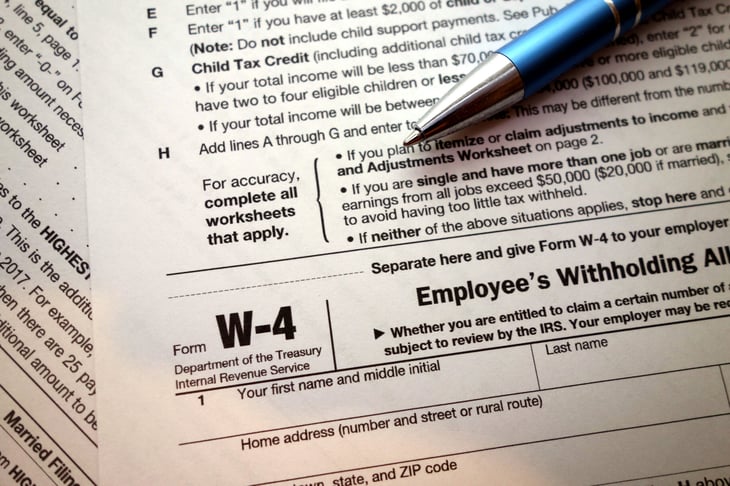
Even if you still haven’t filed your 2023 tax return yet because you requested an extension, it’s a good time to review this year’s tax situation. This is especially true if you expect significant changes to your income.
Whether you hire a tax professional to file your taxes or file them on your own, you can review not only income projections but your possible tax bill too.
Following are key moves you can make right now that could lower the taxes you will owe in 2025. If you are able to implement these steps now, as opposed to later in the year, you’ll have more time to reap the benefits.
1. Review your tax withholding

A big tax refund isn’t necessarily a good thing: It could simply mean that you had too much withheld from your paycheck for taxes throughout the year, which is akin to giving the federal government an interest-free loan.
So, if your last tax refund was too small or too big for your liking, or if you owed taxes this year, it might be time to update your withholding by filling a new Form W-4 with your employer. Or at the least, consider using the IRS Tax Withholding Estimator, a free online tool that can help you determine whether you should withhold more or less from your paycheck this year.
By adjusting how much tax is taken out now, you’ll have more paychecks to spread the extra amount over.
If you’re lucky enough to no longer need a full-time job and are enjoying retirement, you may need to file a Form W-4V or W-4P as you begin to receive Social Security and any pension income, instead of a Form W-4. The other forms enable you to request that more (or less, if appropriate) be withheld from your retirement income this year to avoid paying a hefty tax bill next year.
2. Figure out your income bracket

If you can estimate how much income you will earn this year, you can also project your 2024 income tax rate. Here’s how:
- Figure out your expected income for this year. If you’re unsure or want to be safe, assume it will be higher than your 2023 income.
- Find the corresponding income bracket, or income range, for the tax filing status that you expect to have for 2024 (such as single, head of household, married filing jointly or married filing separately).
- Find the tax rate (percentage) that corresponds to your expected income bracket.
If you find that your expected income puts you near the next-highest income bracket, implementing some of the following moves could keep you from paying more tax.
In other words, these steps can lower your taxable income, which helps ensure that you stay in your expected income bracket rather than getting bumped into the next-highest bracket and thus having to pay a higher tax rate on a portion of your income.
3. Plan out your retirement contributions

You can lower next year’s tax bill by putting away some of this year’s income into a tax-deferred (non-Roth) retirement account. Contributions to such accounts generally are tax-deductible.
If you’re under the age of 50, you can put $23,000 in an employer-sponsored 401(k), for example. That amount increases to a total of $30,500 if you are 50 or older.
Gig workers, small-business owners and other self-employed taxpayers can also lower their taxable income by contributing to a retirement account for the self-employed, if eligible.
Able to put away more? Then consider contributing to a traditional individual retirement account (traditional IRA), if you do not exceed the income limitations. You can squirrel away $7,000 in an IRA if you’re under the age of 50 or a total of $8,000 if you are 50 or older.
You’ll have more time to max out this year’s contributions if you start now.
4. Contribute to an HSA

If you have a high-deductible health plan, consider lowering your taxable income by funding a health savings account (HSA). Contributions are tax-deductible.
For 2024, you can put away up to $8,300 in an HSA if your insurance provides coverage for your whole family. Single individuals can put away $4,150.
If the funds are used for eligible medical costs after you withdraw them, you won’t pay tax on the withdrawals either. Another great feature of these accounts: You don’t have to use up all the money you contributed in the same year. You can let it grow, unlike with a health flexible spending account (health FSA).
5. Contribute to an FSA

If you don’t have access to a high-deductible health plan, you may have access to a health flexible spending account. Health FSAs allow you to put money away before it’s taxed to pay for medical costs, which means contributions are tax-deductible. However, these dollars usually must be used in the same tax year they were contributed.
Check with your employer to find out if you have access to a health FSA — or a dependent-care FSA, for that matter. The latter works like health FSA except the funds can be used to pay for child care expenses instead of medical expenses.
6. Plan out your RMD

Once taxpayers turn 73, they must withdraw a required minimum distribution (RMD) from their tax-deferred retirement accounts each year. The deadline for doing so is Dec. 31, 2024 — and missing that deadline can trigger a steep tax penalty.
So if you must take an RMD for 2024, estimate the amount of the RMD (the IRS offers worksheets and tables to help) and plan for it. For example, do you want to take it all at once or in multiple withdrawals over the course of the year? If you take it all at once, when is the best time for you to do so?
It’s also a good idea to see how this required withdrawal will increase your income and possibly your tax liability for next year.
7. Add up those business expenses

If you are among the millions of Americans who are self-employed, make sure you understand what expenses can be deducted. By tracking your deductible expenses throughout the year, you can lower your taxable income, which likely will lower your taxes next year. You’ll want to keep accurate records of all deductible expense, though.
If you’re not sure what you can deduct, check out “6 Things Every Gig Worker Needs to Know About Taxes” or visit the IRS Gig Economy Tax Center or its Self-Employed Individuals Tax Center to learn more.





Add a Comment
Our Policy: We welcome relevant and respectful comments in order to foster healthy and informative discussions. All other comments may be removed. Comments with links are automatically held for moderation.